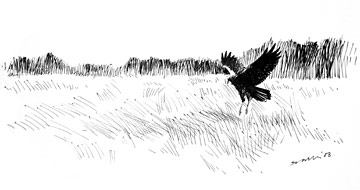
Marsh Harrier © Ray Scally
As the British breeding population has risen, so have the number of birds wintering in the country. Probably no more than ten wintered in Britain in 1981/82 to 1983/84 (Winter Atlas), and Clarke (1995) thought that ‘the number wintering in Britain as a whole probably does not exceed thirty’. Ten years later, several small roosts, containing up to twenty birds each, had become established in eastern and south-eastern England (Brown & Grice 2005).
Cheshire and Wirral has shared in that rise in numbers, especially on autumn passage, with occasional birds on late dates that bring them into our defined winter Atlas period, and some that seem to have been genuinely wintering here. This habit has clearly become more common recently, and the period of this Atlas, with five records, referring to four birds, shows the highest known winter total for the county.
The first on record in the county seems to a bird on 1 December 1946 at Thelwall, followed at intervals of twenty years by another on 30 January 1966 at Wallasey, and then on 18 November 1987 at Moore. After just three birds in forty years there were two during the 1990s, on 1 December 1994 at Fiddler’s Ferry and 22 November 1996 at Great Sankey, then annually from 2001 onwards: 10 December2001 at Bar Mere, then a long-staying bird on the Dee saltmarsh, seen from 19 to 27 December 2002 and again on 20 January 2003, usually going to roost with a Hen Harrier off Parkgate Old Baths. As with some of the others, one on 16 November 2003 at Heswall was probably just a late migrant, but the bird on 1 February 2004 on the Mersey at Ince was not (Bell 1967, CWBRs).
Marsh Harriers normally migrate south for the winter, reaching southern Europe at least, with some in Africa including roosts of hundreds seen in Senegal (Clarke 1985, Migration Atlas). There is significant sexual dimorphism in this species, and most of those attempting to winter here are the larger females. They feed especially on waterfowl, up to the size of large ducks, but will take any suitable prey including carrion.Sponsored by David Kennerley

